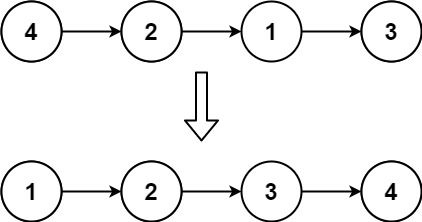代码拉取完成,页面将自动刷新
同步操作将从 doocs/leetcode 强制同步,此操作会覆盖自 Fork 仓库以来所做的任何修改,且无法恢复!!!
确定后同步将在后台操作,完成时将刷新页面,请耐心等待。
Given the head of a singly linked list, sort the list using insertion sort, and return the sorted list's head.
The steps of the insertion sort algorithm:
The following is a graphical example of the insertion sort algorithm. The partially sorted list (black) initially contains only the first element in the list. One element (red) is removed from the input data and inserted in-place into the sorted list with each iteration.

Example 1:

Input: head = [4,2,1,3] Output: [1,2,3,4]
Example 2:

Input: head = [-1,5,3,4,0] Output: [-1,0,3,4,5]
Constraints:
[1, 5000].-5000 <= Node.val <= 5000# Definition for singly-linked list.
# class ListNode:
# def __init__(self, val=0, next=None):
# self.val = val
# self.next = next
class Solution:
def insertionSortList(self, head: ListNode) -> ListNode:
if head is None or head.next is None:
return head
dummy = ListNode(head.val, head)
pre, cur = dummy, head
while cur:
if pre.val <= cur.val:
pre, cur = cur, cur.next
continue
p = dummy
while p.next.val <= cur.val:
p = p.next
t = cur.next
cur.next = p.next
p.next = cur
pre.next = t
cur = t
return dummy.next
/**
* Definition for singly-linked list.
* public class ListNode {
* int val;
* ListNode next;
* ListNode() {}
* ListNode(int val) { this.val = val; }
* ListNode(int val, ListNode next) { this.val = val; this.next = next; }
* }
*/
class Solution {
public ListNode insertionSortList(ListNode head) {
if (head == null || head.next == null) {
return head;
}
ListNode dummy = new ListNode(head.val, head);
ListNode pre = dummy, cur = head;
while (cur != null) {
if (pre.val <= cur.val) {
pre = cur;
cur = cur.next;
continue;
}
ListNode p = dummy;
while (p.next.val <= cur.val) {
p = p.next;
}
ListNode t = cur.next;
cur.next = p.next;
p.next = cur;
pre.next = t;
cur = t;
}
return dummy.next;
}
}
/**
* Definition for singly-linked list.
* function ListNode(val, next) {
* this.val = (val===undefined ? 0 : val)
* this.next = (next===undefined ? null : next)
* }
*/
/**
* @param {ListNode} head
* @return {ListNode}
*/
var insertionSortList = function(head) {
if (head == null || head.next == null) return head;
let dummy = new ListNode(head.val, head);
let prev = dummy, cur = head;
while (cur != null) {
if (prev.val <= cur.val) {
prev = cur;
cur = cur.next;
continue;
}
let p = dummy;
while (p.next.val <= cur.val) {
p = p.next;
}
let t = cur.next;
cur.next = p.next;
p.next = cur;
prev.next = t;
cur = t;
}
return dummy.next;
};
此处可能存在不合适展示的内容,页面不予展示。您可通过相关编辑功能自查并修改。
如您确认内容无涉及 不当用语 / 纯广告导流 / 暴力 / 低俗色情 / 侵权 / 盗版 / 虚假 / 无价值内容或违法国家有关法律法规的内容,可点击提交进行申诉,我们将尽快为您处理。